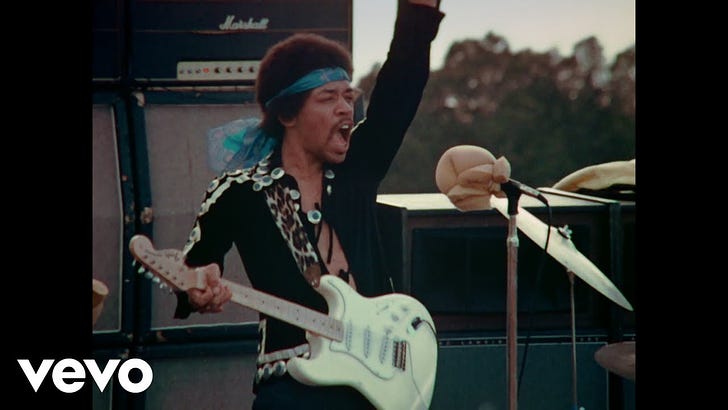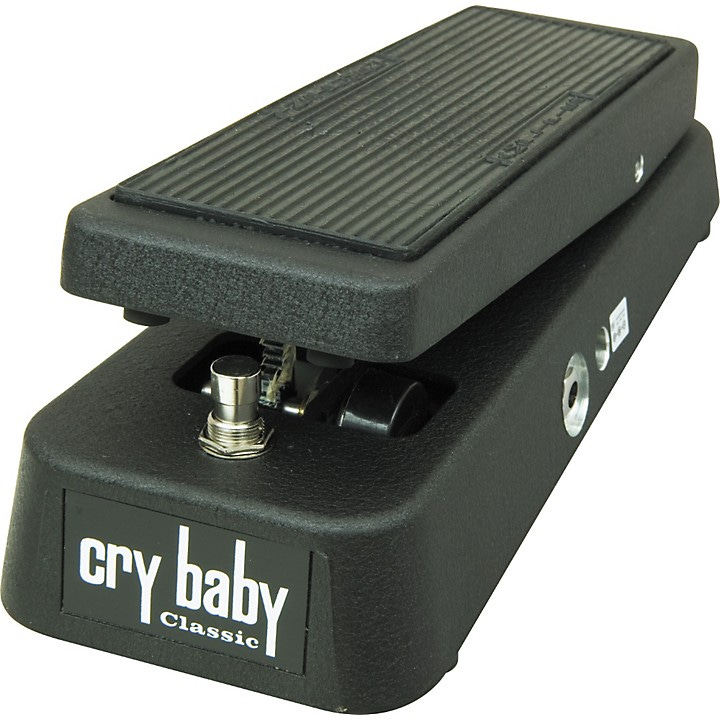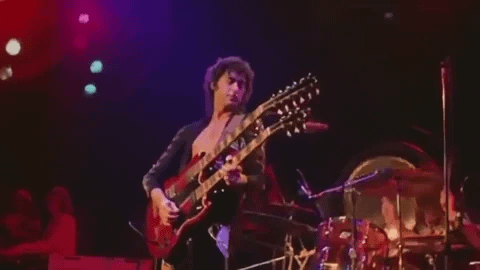In the last post, we met Jim Morrison, the frontman of The Doors and a self-described shaman. I like this metaphor because, in this new psychedelic world, the musician becomes a spiritual guide, a sherpa of the trip.
They’re elevated beyond singers. They’re now prophets. They’re cult-like figures. They’re rockstars.
The Cult of Personality
People want something, someone to believe in. To obsess over. To become a fanatic.
Music channels this energy, speaking to young adults in their language, using the latest (loud) technology, and elevating the band on a stage in front of an adoring crowd. The goal is to lose yourself in the music. And the front person is the orchestrator, the leader, the shaman. They take you on that trip. Together.
It’s bringing the teenage obsession of The Beatles into adulthood, to the messy world of war and love and fear and release.
This energy can be palpable. It builds. It grows. Like fire:
That’s different.
Just a decade earlier, the big scandal was Elvis’ hip gyrations. Now we’re deep down the rabbit hole. Will you follow us, Alice?
Jimi Hendrix, the Virtuoso
Like other great innovators, Jimi took advantage of the technology of the day. Here’s one example, the wah-wah pedal:
A wah pedal is an equalization sweep effect, shifting a band-pass filter up and down to shift the emphasis of different frequencies running through the pedal. In simpler terms, it makes the guitar brighter and darker depending on how you’re rocking the pedal up and down. It’s like a hyped-up tone knob, shifting the intensity and allowing for new interactions between the attack of the guitar pick and the output of the guitar.
Normally, when you attack or strike the guitar, it is naturally brighter at the moment of your attack then darkens as the sound decays and sustains. With a wah, you can darken the guitar as you attack (by shifting the pedal down towards you) then brighten the guitar directly after (by shifting the pedal up away from you). You can invert expectations!
Here’s the best to ever do it, playing one of my favorite songs:
Fun fact: The wah pedal was accidentally invented in 1966 when the engineers were designing the Vox Super Beatle amplifier. That amp was designed because The Beatles were performing for larger crowd sizes than ever before. So they needed more power. Interestingly, as you add more power, you draw more crowds and then have to increase the power. That feedback loop (pun intended) gets us Jimi, Led Zeppelin, and eventually… hair metal. But all in due time.
A Shift in Creative Control
The music business chased this energy, this crowd, this paycheck. As artists that tapped into chaos and shamanic adventurism drew attention, they also drew in business people. Labels (who at this time were more focused on music than modern times but also realistic about its profit potential) turned over creative control to artists. Fans, for their part, rewarded the artist’s creative exploration. They were up for the ride.
This creative-business feedback loop drew momentum, changing the face of the industry and leading to…
The Concept Album
Pet Sounds by The Beach Boys (1966) pushed the boundaries of what an album could be. Yes, in the sea of psychedelics and upstarts, the good-guy heroes of the surf rock revolution kicked off the concept album!
Everyone — and I literally mean everyone in the world — should listen to the complete album in mono.
Why mono? (Well, I have a post all about it!) TLDR; The Beach Boys produced this for one speaker, not two. The LP sounds very, very different using the technology of stereo (two speakers). So stick with the OG, the way it was intended. Meet it on its own terms. Trust me.
Paul McCartney of The Beatles heard this LP, and it kicked his ass. He was pushed by the competition and set out to one-up Brian Wilson and The Beach Boys.
The Beatles’ 1967 response, Sgt. Pepper's Lonely Hearts Club Band, doubled down on the idea of an album, rather than a collection of singles. Sgt. Peppers had a loose concept, following a fictional band exploring different musical styles. While it wasn’t a cohesive story like the rock operas to come, it was a seismic shift from the typical pop record — experimental and avant-garde; orchestral yet hard-hitting.
Listen to the whole record (in mono!), but if you only have time for one song, let it be this one. The greatest closing track of all time:
And check out that album art! Designed by Peter Blake and Jann Haworth, the album cover features over 70 famous faces, from Albert Einstein to Bob Dylan. If you look in the third row next to the letter N, you’ll see Stuart Sutcliff, the original bassist (and “art director”) of The Beatles, who tragically passed away.
Here’s a wiki article about everyone featured on the cover, complete with a numerical sorting system.
The Supergroup: Cream
A supergroup is a rock band featuring known/previously famous, virtuosic players joining forces to push boundaries. Cream, featuring Eric Clapton (from The Yardbirds, John Mayall), Jack Bruce (The Graham Bond Organisation, John Mayall & the Bluesbreakers, Manfred Mann), and Ginger Baker (The Graham Bond Organisation), was one of the first supergroups, featuring blisteringly awesome improvisation and a synthesis between blues-rock and psychedelic.
Remember Robert Johnson and his Cross Road Blues from our first post in this series? Here’s a cover by Cream, with some of the best guitar solos ever played:
If you liked that video, I’d recommend checking out their LP, Disraeli Gears. And any blues-loving guitarists should learn those songs! Homework!
(Literal) Creative Destruction
Check out the last minute of this video from 1967. Here The Who take postmodern art and performance art onto the rock stage, breaking their instruments and making a statement of creative distruction:
Something’s happening in rock. It’s dangerous. And it’s alluring like moths to a flame.
Welcome to Woodstock
It’s freedom. Creativity. Rebellion. Woodstock in 1969 defined the classic period of rock, wrapped up in the anti-Vietnam sentiment and shift towards a new America. It was the capstone of the psychedelic movement — a pop-up city that became the symbol of the counterculture.
Yep, the promoters expected around 50,000 people. They got a half million.
Performers at this free concert included legends like Jimi Hendrix, The Who, Janis Joplin, Santana, Crosby, Stills, Nash & Young, and Jefferson Airplane.
Jimi’s chaotic performance of “the Star-Spangled Banner” summed it all up. It was simultaneously protest and patriotic. Aspirational and destructive. In other words, ART!
Woodstock wasn’t utopia. It was spontaneous and ugly and raw. There wasn’t enough food, medical, sanitation, or housing. The rain poured, the pits of mud beckoned and swallowed drug users, but the mythos of the space, the idea of a sacred, free collective, prevailed.
Sounds like a trip.
An Unlikely (Rock) Opera
One of my favorite parts of The Who is their inherent contradiction. Like the Abbot and Costello bit, The Who was simultaneously an aggressive, destructive, loudest-band-in-the-world AND sentimental, musical, and sensitive songsmiths.
Enter the rock opera, Tommy. 1969.
The rock opera tells the story of a young boy, Tommy Walker, who becomes deaf, dumb, and blind after witnessing a traumatic event. Despite his disabilities, Tommy develops an extraordinary skill in playing pinball, becoming a "Pinball Wizard" and gaining a cult-like following. As a Jesus-like figure, Tommy transcends, spiritually awakens, and liberates his followers from their limitations… through pinball. Now that’s a story-based concept album!!!
It was adapted into a movie in 1975, and for now, it’s free on Internet Archive — if you dare dive into The Who’s bizarre, psychedelic (and awesome) world.
Led Zeppelin: The Rock Gods
As we’ve seen, rock stars were no longer just musicians; they were performers in larger-than-life productions. And no one embodied that more than Led Zeppelin.
Indeed, the bigger the shows, the bigger the amps, the bigger the theatrics, the bigger the hair!
ROCK!
Jimmy Page (guitar) was a session guitarist and previous member of The Yardbirds. He was the primary songwriter, visionary, and founder of the band.
Robert Plant (vocals) was influenced by American blues singers like Howlin’ Wolf and Muddy Waters. He was also into folklore, mythology, and The Lord of the Rings, bringing new sorts of lyrical exploration to the genre.
John Paul Jones (bass/keyboards) was also a session musician and arranger, who worked with Dusty Springfield and The Rolling Stones. He had crazy chops, bringing a virtuosity to the bass guitar similar to John Entwistle of The Who.
Finally, John Bonham is the drummer every drummer wants to be. His organized chaos, his signature, powerful style, and his effortless virtuosity continue to captivate anyone who picks up the sticks.
Like a Lead Balloon
Keith Moon of The Who (or was it John Entwistle, there’s debate) joked the band “would go over like a lead balloon” in 1966 when they were jamming together in the studio. Jimmy Page remembered the joke when he formed Led Zeppelin in 1968, after the Yardbirds broke up.
(Page dropped the "a" from "lad" so people wouldn't pronounce it "lead" and replaced "balloon" with "Zeppelin.”)
Artistic Control Is a Powerful Thing
Led Zeppelin famously negotiated one of the most artist-friendly contracts in the history of rock music with Atlantic Records. Their manager, Peter Grant, ensured they had complete artistic control, retained a significant share of the profits, and owned their recordings. That’s a big deal — and a big part of the reason why they got so legendary and so weird!
Thank You, Audience
I started this Substack and podcast because I believe fans make the artists. If we love music more, the music gets better.
When there’s a market for artists to be artists, see what happens?
And when there’s no money or attention in being different, exploring, and pushing boundaries — guess what that music sounds like?
So please, take the energy these fans showed in the late sixties and early seventies. Embody it and give it back to the artists you love today. No, it doesn’t take stadiums to make great music, but it always takes accepting and engaged fans. That is a prerequisite across every single great band. Great fans make great artists. Not the other way around.
Embrace their exploration, cheer on their twists and adventures, and celebrate those who push music forward. Too often, those that push, get shunned. They get poor lol.
Or those that could fly get hemmed in by fans who want the same sound.
Or by algorithms that demand genre adherence.
Do we want the same music, the same record over and over… or do we want to be surprised? Do you want to be taken on a trip by a musical shaman?
You decide. Every time you pick which song to listen to.
—
On that note, listen to this podcast I made on music’s felt value. Let there be sound!
—
Thanks for reading internet friend,
Scoob









I love Led Zeppelin they are truly certified rock gods. Dazed and Confused is my favorite song by them and just watching that performance shocked me. Jimmy page playing his guitar with a violin now is so unexpected but creative I love it!
John Boeman was a cool drummer. It was amazing to me to see how much drummers looked up to him.